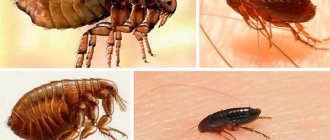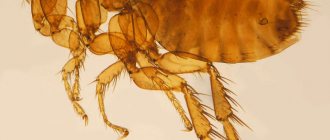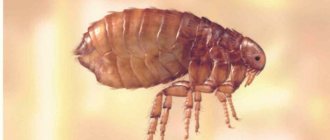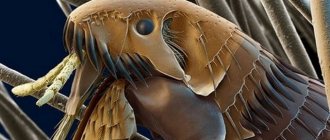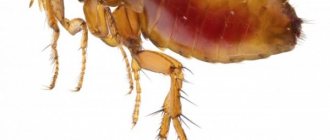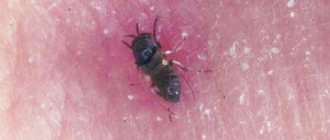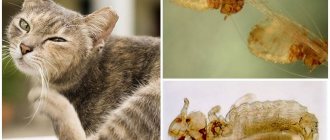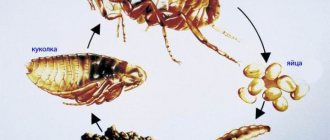Are there human fleas?
When choosing a host, blood-sucking insects prefer animals with rich vegetation. The latter allows the parasite to gain a proper foothold, providing it with protection from the external environment. Therefore, cat and dog fleas are rare in humans.
In nature there is a parasite called Pulex Irritans. For successful life, he does not need thick wool. The insect prefers to hide in interior items and other secluded places, and if necessary, goes hunting. It was this subspecies that received the name “human flea.” The parasite lives everywhere, but like other blood-sucking pests, it loves regions with warm climates.
Flea bite
Symptoms of fleas in humans
The appearance of fleas is difficult to miss. Their bites are very painful, so these parasites do not inject any painkillers into the victim’s body before biting. The flea injects a special enzyme into the wound that prevents the blood from clotting. This action is aimed at increasing bleeding and quickly satiating the insect. A red, itchy microinflammation remains at the site of the bite. Small wounds, scabs and scabs may appear. If you constantly scratch the bite sites, a person may suffer from swelling. The main places for bites are the areas with the thinnest skin - wrists, shins, ankles, neck. Fleas always attack in large numbers, that is, many bites appear on the body at once. It is recommended to treat these areas with any antiseptic to avoid the risk of inflammation and possible infection. But, unfortunately, seeing a flea is very problematic - they are very fast and elusive when jumping.
Danger of fleas
As you know, parasites are carriers of many dangerous diseases. And fleas are no exception. Recent studies have shown the presence in them of microorganisms that are the source of diseases such as plague, encephalitis, anthrax, brucellosis, salmonellosis, tularemia, and helminthiasis. The list of diseases depends on the region. Of course, such cases are very rare and unlikely, but, nevertheless, such a danger exists. The more common consequences of a flea bite are all kinds of allergic reactions, fever, the appearance of ulcers on the body and mucous membranes, headaches, inflammation at the bite sites, and enlarged lymph nodes. Fleas in humans can also cause insomnia and neurosis due to persistent itching.
Flea control methods
First you need to get rid of fleas parasitizing on the body and eliminate the possibility of them jumping on a person. To do this, just wash yourself - these insects are afraid of water. To enhance the effect, use tar soap. Its smell repels parasites.
As with any other parasites, controlling fleas in your home requires a comprehensive approach. It is necessary to treat all possible habitats of fleas and their larvae. It is better to clean in the following sequence:
- Vacuum and shake out all carpets or other soft floor coverings. The best option, of course, would be dry cleaning - in this case, the destruction of parasites is guaranteed;
- Floors must be washed thoroughly, preferably with a disinfectant. Pay special attention to corners, baseboards and crevices;
- Wipe dust on all surfaces;
- All bedding must be washed, beds must be washed, upholstered furniture and mattresses must be shaken out, steamed and disinfected;
- If there are pets in the house, they must be washed with a special insecticidal agent.
Currently, there are many means to combat parasites. But, when using any of them, it is advisable to repeat the treatment after 1-1.5 weeks to obtain an ideal result.
If you are not sure of the effectiveness of the measures taken, it is recommended to call a special service for disinfection and disinfestation of the house. In this case, you will get a faster and more guaranteed result. But it will be necessary to leave the house for some time, since professional chemical preparations for killing parasites are very harmful and dangerous to health. All rooms after the disinfestation procedure need to be thoroughly ventilated.
It should be noted that fleas are rare in humans, but this possibility exists. The main thing is to take all necessary measures in a timely manner to get rid of these unpleasant parasites. And the best remedy is prevention - keeping your home clean and caring for your pets.
Features of the human flea
The pest prefers to establish itself in places where people are present for quite a long time: bedrooms, offices, etc. The flea also lives in clothes. The insect tries to avoid kitchens and bathrooms because its natural enemies, cockroaches and ants, are common here.
Favorite places for fleas are cracks between floorboards, baseboards, upholstered furniture, carpets and other interior items. Development occurs outside the human body, that is, the parasite has no carrier in principle. The pest periodically goes out hunting, and then returns to its secluded place.
For reference! One female Pulex Irritans can lay up to 1,000 eggs, which is at least twice as many as dog and cat fleas. Over the entire period of its existence, which is about 1.5 years, an individual breeds offspring about 500 times.
How can you tell if there are fleas?
Finding out the presence of a parasite is not so difficult, since insect bites are quite painful and are located in certain areas. It is a mistake to believe that fleas live on the head - in the hair, confusing them with lice and other parasitic pests. The insect feels great on a bare body: legs, arms, back or stomach.
Symptoms of fleas on humans:
- increasing redness;
- itching and burning at the bite sites;
- the presence of barely noticeable ulcers;
- concentration of bites in one area (legs, arms, etc.).
As soon as fleas appear, they immediately begin to attack a person. That is, there will always be a lot of bites, and not, as is the case with bedbugs, from fewer to more.
Pet Protection
Dogs and cats must wear collars with repellent components or use special drops. If you prevent insects from appearing on your pets, then the chances of a person being bitten are much less. Cat fleas on humans in most cases appear when their pets go for a walk, visiting less well-groomed representatives of the genus. To avoid this, the bedding is thoroughly washed, then wormwood is laid out on it. The animals themselves need to be bathed in Butox solution.
To understand whether your pets have parasites, it is enough to observe their behavior. An allergy to fleas in humans is expressed in the form of scratching on the body and redness on the skin. In animals, in principle, everything is the same. Due to dermatitis, they develop a “flea triangle”, that is, an area of baldness on the rump. If, in addition to the parasites themselves, such a reaction is observed, then glucocorticoids are additionally prescribed.
Are fleas transmitted from animals to humans?
Animal fleas live on fur. It provides them with the necessary protection, as well as conditions for reproduction. With thick fur it is easy to hide from the eyes of the owner, and combing them out of their homes is not so easy.
Fleas jump on people from animals and bite them, but for comfortable development they need more or less reliable shelter. But this cannot be found on the human body due to the specificity of Homosapiens. Fleas cannot live in human hair because the person has too little of it. The parasite contacts people according to the principle of eating and hiding.
What fleas can bite humans
In addition to Pulex irritans, other species of this family that do not have a clear attachment to certain species of animals or birds can attack people.
Most often we are bitten by insects that live on:
- dogs;
- cats;
- rats. Rat fleas were carriers of the most terrible medieval disease - the plague;
- rabbits.
The most painful flea bite can be obtained from a parasite that lives on a large animal. For example, a moose flea bite is more painful than a bee bite.
Do fleas live on humans?
A blood-sucking insect can attach itself and live on almost any warm-blooded animal. However, when it comes to whether fleas live on people, in this case no, because for them people are a source of food, not a carrier. Having drunk blood, the parasite retreats to its shelter to rest and reproduce. Widespread cat or dog fleas also cannot live on humans.
Habitats
Representatives of the Pulex Irritans family are more adapted to bare skin. Thanks to their tenacious paws, they can last on the human body much longer than their cat or canine counterparts. But again, these fleas do not live on people, but only feed on their blood.
Description of the parasite
The homeland of the human flea is South America. In the past, it was one of the main carriers of plague along with the rat flea.
The length of the body does not exceed three millimeters, the color is dark brown. A durable chitinous shell protects from damage, and bristles on the paws provide adhesion to animal fur.
The insect's jumps reach 30 centimeters in height and half a meter in length. The human flea has an excellent reaction, so it is almost impossible to catch it. He prefers cats and dogs as victims, but sometimes he doesn’t mind feasting on human blood.
The female is capable of laying up to 500 eggs. Metamorphosis into an adult insect takes from 2 weeks to one year.
What do flea bites look like?
The activity of parasites is recognized by small and dense red areas on the skin. Fleas prefer to bite the legs and feet. It is there that numerous capillary branches take place. Insects can attack other parts of the body from clothing.
The bites are especially noticeable on children and allergy sufferers. The former have delicate skin, and the body of the latter reacts critically to the intervention of any blood-sucking insects. In the center of the problem area you can see a small hole, usually with suppuration. After attacks by parasites, a kind of track is formed on the legs.
Important! You should not scratch bites. The wounds begin to fester, which opens the door to fungal and infectious diseases. Even if the flea is not infected, it is not a fact that under a person’s nails is sterile.
Methods of disposal
Let's figure out how to get rid of fleas on the body and indoors. The only panacea for a parasite attacking a person is repellents. The active substances included in the preparations repel and/or poison the insect, forcing it to leave the hunting area.
To get rid of fleas in the room, you should carry out a general cleaning and treat the interior items with insecticides. All laundry must be washed in the hottest possible water and then dried thoroughly.
In winter, freezing helps: at -15...20⁰C the flea dies. It is enough to open all the windows for a few hours, and then vacuum the carpets, sofas and other objects with a fleecy surface.
Important! The main source of fleas is pets. They need to be dealt with first: bathe with special shampoos and gels, put on a flea collar.
Things to know
In order to understand in time what you are dealing with, you must know what flea bites look like on a person. This is the only way you can distinguish them from mosquito bites, bed bug bites, or an allergic reaction to food. Fleas cause the most discomfort when they bite. Allergic swelling may occur within a few hours. Its intensity will depend on the individual characteristics and inclinations of the person. In addition to the fact that the affected area itches, it also hurts a lot.
Since flea bites on humans look the same as mosquito bites, it is the pain of the bitten area that makes it possible to understand that this is a mark from another insect. Unlike mosquitoes, these bloodsuckers do not inject an anesthetic substance. Instead, only irritating saliva enters the body.
Treatment of bites
All treatment comes down to relieving symptoms, that is, itching, burning and pain. It is also necessary to disinfect the problem area to avoid infection. At home, regular laundry soap or antibacterial soap is suitable.
It will not hurt to apply some cool object, such as ice wrapped in gauze, to the bite site. Every first aid kit probably contains hydrogen peroxide or iodine. Treatment with these products will help prevent infection.
For treating bite sites
Pharmaceutical drugs:
- Levomekol. Disinfects festering wounds.
- Boro-plus. Inexpensive cream without aggressive substances. Helps with irritations.
- Fenistil. The gel relieves burning and inflammation.
- Hydrocortisone. This is a serious hormonal drug. Helps in severe cases: pronounced swelling and severe pain.
Folk remedies:
- Mix water with table vinegar in equal proportions and use a swab to treat problem areas.
- 1 tsp We dilute baking soda in a glass (200 g) of warm water and apply it to the affected area as a compress.
- We disinfect the bite site with a decoction of natural green tea or agave.
Important! If, after prolonged contact with the parasite, a sharp rise in temperature, weakness and severe headaches are observed, then it is necessary to urgently consult a doctor and not self-medicate.
How to protect yourself
Animal owners especially often have to deal with the consequences of fleas. But no one can be immune from insects. If fleas decide to live in a house, comprehensive treatment of the home is needed.
It includes:
- freeing pets from insects:
- washing all bedspreads, blankets, curtains, processing upholstery and covers;
- processing the yard and buildings, cutting the grass;
- dismantling and processing of storage rooms and closets.
You will have to shake up the whole house to prevent contamination of secluded places where insects like to live.
To avoid getting infected, you need to avoid going to landfills and the habitats of stray animals, and avoid contact of domestic cats and dogs with them. Anyone who ends up in such places should be inspected and their clothes should be thoroughly shaken out before returning home.
Head disinfection
Fleas of any kind, including human ones, do not live in human hair. To remove individual individuals, it is enough to wash your hair regularly. It is useful to use tar soap or shampoos that are sold in pharmacies against lice and nits.
Treatment of wounds from bites
Special wound treatment is only relevant in cases of infection and severe scratching. In most cases, wounds heal within 1-3 days without any trace.
If there are signs of an allergy, you should consult an allergist, especially if irritation persists after taking antihistamines.
You can lubricate the damage with the following preparations:
- iodine;
- Calamine;
- Fenistil;
- tinctures of chamomile, plantain.
If severe itching occurs, the doctor may prescribe medications with glucocorticosteroids for local (Sinaflan, Hydrocortisone) or oral use.
It is better not to use such means on your own.

